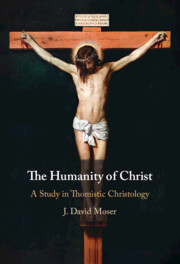Refine search
Actions for selected content:
84 results
2 - Translation
- from Part I - Introduction and Translation
-
- Book:
- The Gospel of Truth
- Published online:
- 23 October 2025
- Print publication:
- 06 November 2025, pp 20-42
-
- Chapter
- Export citation
14 - Christology and the Eucharist
- from Part IIIa - Christology and Systematic Theology
-
-
- Book:
- The Cambridge Companion to Christology
- Published online:
- 15 September 2025
- Print publication:
- 02 October 2025, pp 234-250
-
- Chapter
- Export citation
20 - Christology and Political Theology
- from Part IIIb - Christology and Philosophical Theology
-
-
- Book:
- The Cambridge Companion to Christology
- Published online:
- 15 September 2025
- Print publication:
- 02 October 2025, pp 340-358
-
- Chapter
- Export citation
19 - Christology and Holiness
- from Part IIIb - Christology and Philosophical Theology
-
-
- Book:
- The Cambridge Companion to Christology
- Published online:
- 15 September 2025
- Print publication:
- 02 October 2025, pp 323-339
-
- Chapter
- Export citation
18 - Christology and Consistency
- from Part IIIb - Christology and Philosophical Theology
-
-
- Book:
- The Cambridge Companion to Christology
- Published online:
- 15 September 2025
- Print publication:
- 02 October 2025, pp 305-322
-
- Chapter
- Export citation
17 - Christology and Metaphysics
- from Part IIIb - Christology and Philosophical Theology
-
-
- Book:
- The Cambridge Companion to Christology
- Published online:
- 15 September 2025
- Print publication:
- 02 October 2025, pp 287-304
-
- Chapter
- Export citation
13 - Christology and the Atonement
- from Part IIIa - Christology and Systematic Theology
-
-
- Book:
- The Cambridge Companion to Christology
- Published online:
- 15 September 2025
- Print publication:
- 02 October 2025, pp 219-233
-
- Chapter
- Export citation
Introduction
-
-
- Book:
- The Cambridge Companion to Christology
- Published online:
- 15 September 2025
- Print publication:
- 02 October 2025, pp 1-6
-
- Chapter
- Export citation
7 - Theological Benefits of the Instrumental Doctrine
- from Part III - Theological Implications
-
- Book:
- The Humanity of Christ as Instrument of Salvation
- Published online:
- 21 August 2025
- Print publication:
- 04 September 2025, pp 201-225
-
- Chapter
- Export citation
Introduction
-
- Book:
- The Humanity of Christ as Instrument of Salvation
- Published online:
- 21 August 2025
- Print publication:
- 04 September 2025, pp 1-12
-
- Chapter
- Export citation

The Humanity of Christ as Instrument of Salvation
- A Study in Thomistic Christology
-
- Published online:
- 21 August 2025
- Print publication:
- 04 September 2025
105 - Annianus of Alexandria, Chronography
-
- Book:
- The Fragmentary Greek Chronicles after Eusebius
- Published online:
- 11 September 2025
- Print publication:
- 24 July 2025, pp 215-309
-
- Chapter
- Export citation
11 - Preaching on the Totus Christus
- from Part III - Augustine’s Preaching Themes
-
-
- Book:
- The Cambridge Companion to Augustine's Sermons
- Published online:
- 26 May 2025
- Print publication:
- 12 June 2025, pp 209-225
-
- Chapter
- Export citation
Towards a grammar of theocentric belonging: Kilby, Tanner and beyond
-
- Journal:
- Scottish Journal of Theology / Volume 78 / Issue 3 / August 2025
- Published online by Cambridge University Press:
- 06 March 2025, pp. 229-239
- Print publication:
- August 2025
-
- Article
- Export citation
4 - Orthodox Foundations
- from Part II - An Emerging Story
-
- Book:
- Constructing an Incarnational Theology
- Published online:
- 09 January 2025
- Print publication:
- 23 January 2025, pp 87-113
-
- Chapter
- Export citation
1 - An Incarnational Theology
- from Part I - The Story of God
-
- Book:
- Constructing an Incarnational Theology
- Published online:
- 09 January 2025
- Print publication:
- 23 January 2025, pp 9-23
-
- Chapter
- Export citation
8 - God’s Purpose
- from Part III - Reconfiguring the Story
-
- Book:
- Constructing an Incarnational Theology
- Published online:
- 09 January 2025
- Print publication:
- 23 January 2025, pp 188-215
-
- Chapter
- Export citation
10 - Constructive Approaches to the Historical Reality of Physicalism
-
- Book:
- Human Salvation in Early Christianity
- Published online:
- 09 January 2025
- Print publication:
- 23 January 2025, pp 289-306
-
- Chapter
- Export citation
God Did Not Choose to Save the World by Talk: E.L. Mascall on the Incarnation and Its Consequences
-
- Journal:
- Journal of Anglican Studies / Volume 22 / Issue 2 / November 2024
- Published online by Cambridge University Press:
- 13 January 2025, pp. 542-557
-
- Article
- Export citation
22 - The Future of Jesus of Nazareth
- from Part V - Outlook
-
-
- Book:
- The New Cambridge Companion to Jesus
- Published online:
- 15 November 2024
- Print publication:
- 05 December 2024, pp 365-378
-
- Chapter
- Export citation
